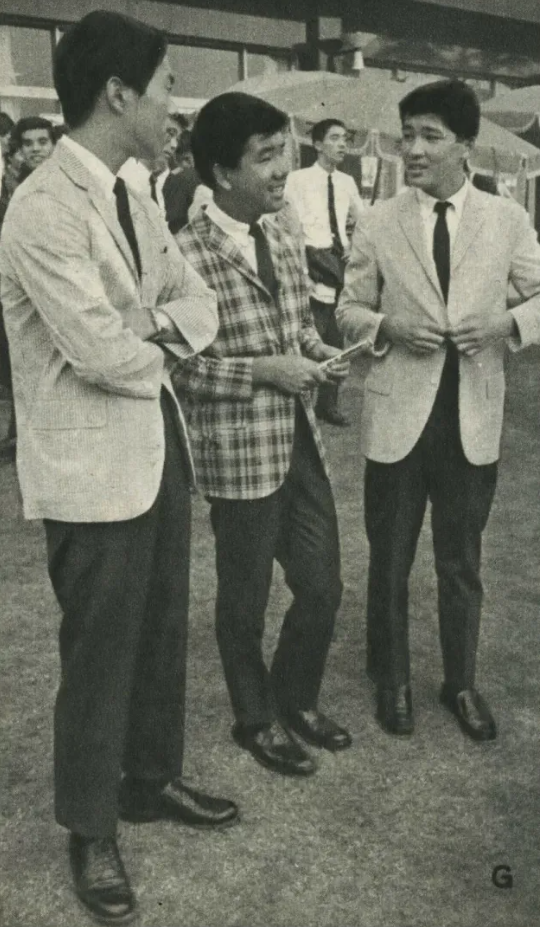The word Ametora means “American Traditional” in Japanese which started in Japan in the 80’s. This style was initially influenced by the style of east coast ivy league college students which were documented by four Japanese style enthusiasts from between 1959 and 1965. This book became a huge success by selling over 50,000 copies worldwide since its release [1].

Japanese youth wearing Ivy style, circa 1965
Many Japanese companies started off making copies of the American made garments such as Jeans, Jackets, and military inspired gear due to the high cost of getting the made in the USA pieces out in Japan [2].

American Style in Japan in the mid 80’s
This evolution of American style garments has resulted in many brands taking contemporary pieces and adding different materials and silhouettes while still retaining the original idea. A very influential brand that came to existence from this new wave of “American fashion” was Kapital. Kapital was started in 1980 by Toshikiyo Hirata who discovered American denim after a trip to the united states. He decided that he would pursue the craft of denim making to bring American raw-denim to Japan. Four years later in 1984 he opened his first factory in 1984 in Kojima Japan. His son, Kiro Hirata, followed his fathers footsteps and after going to College in the United States he joined his father and began working on designing more contemporary pieces with the same quality and fabrics that Kapital was known for. Today, they still manufacture all pieces in the same factory that they started in still focusing on combining traditional Japanese fabric techniques. Notably, Boro [3]

Kapital Jacket using Boro Stiching Techniques
which is the practice of reworking and repairing textiles through unique patch work and Sashiko [4]

Shashiko Repair on a pair of Japanese selvedge denim
which involved traditional Japanese embroidery used for decorative and functional reinforcement of the fabric. One piece about the story of this style that really stuck out to me was that this introduction was the first time this style was exposed to Japan and most people at that time did not have any style inspiration on how to dress like that. This is where Japanese Magazine play a pivotal role in the spread and adaptation of the this new style. Many new brands had the opportunity to showcase their new designs and styles to entice new customers to come to their stores and purchase items they saw in the catalogs. This pop-culture shift began the start of many iconic Japanese brands such as WTAPs, Yohji Yamamoto, Bape, Neighborhood, and Issey Miyake. All these brands drew from inspirations from various pieces of American history with more military focus from brands like WTAPS and Issey Miyake Sport [5]

Issey Miyake Sport Bomber Jacket from the 80’s
to more “streetwear” style clothing with louder graphics and patterns from Bape and Neighborhood while still retaining the style that is unique to Japan. I recently had the opportunity to visit Japan and see first hand the unique style and aesthetic that many Japanese people had in Tokyo and Osaka. I found my self stumbling into many vintage stores that focused on older American wear as well as Japanese brands where the whole focus is the “western” style of the US [6].

American Style Japanese Clothing in Osaka Japan
Images:
[1] https://www.gq.com/story/ametora-author-interview-american-japan-style#:~:text=What%20is%20Ametora%3F,British%20items%20like%20fisherman’s%20sweaters. [2] https://mr-mag.com/why-do-the-japanese-love-americana-so-much/ [3] https://www.incu.com/products/ek-1291-ind [4] https://www.ebay.com/itm/133925625378 [5] https://www.ebay.com/itm/165277053534Information comes form the following links:
https://en.wikipedia.org/wiki/Take_Ivy

3 Comments. Leave new
[…] cách thời trang Ametora, hay còn được gọi là American Traditional. Nó đã trở thành một xu hướng thời […]
This aesthetic is interesting because it feels very familiar to American fashion, but it has it’s own unique twists. I think the cultural differences between the US and Japan contribute to these slight differences in style. Generally when I think of Japanese style I have a view of business men in suits, rather than denim and street wear. This post was very insightful, thanks!
This post was an interesting read about a subject that I was not too familiar with. Although I have heard of some of the brands mentioned, it was fascinating to learn about their historical backgrounds. One question I had was: Are there other cultures (besides American) that Japanese fashion brands take influence from?